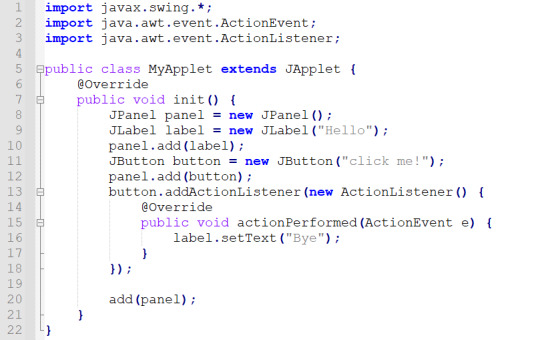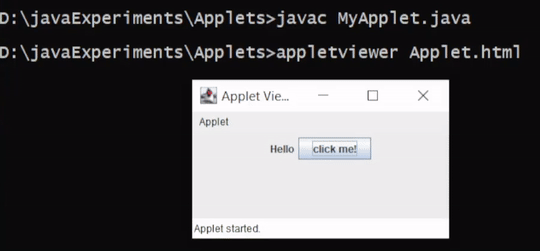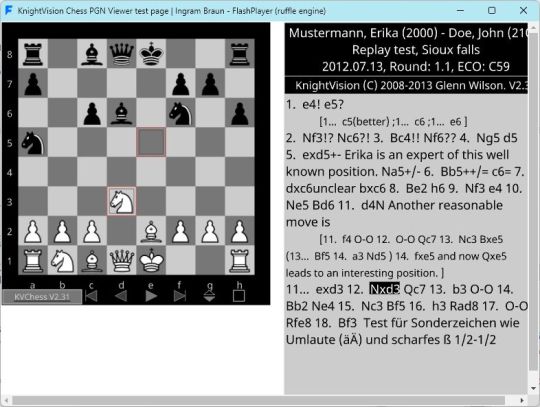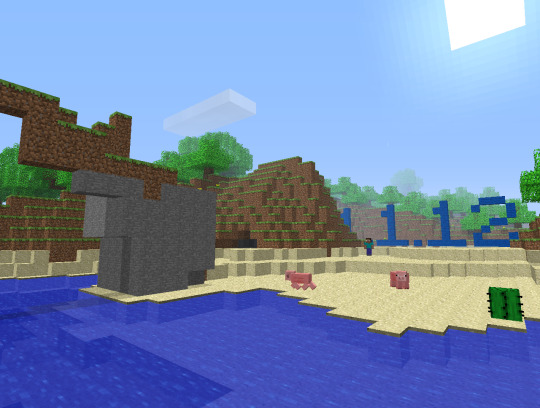#java applets
Explore tagged Tumblr posts
Text
Как создать и запустить у себя Java апплет в 2024 году?
Апплеты - устаревшая технология, которая позволяла запускать java-программы в браузере пользователя.
В JDK 9 они были объявлены устаревшими, а в JDK 11 их уже не было. Поэтому в первую очередь на компьютере нам понадобится JDK 8

В папке создаём java-файл и html-файл

Java-код для простого апплета, состоящего из надписи и кнопки

HTML-код

Открываем командную строку (это можно сделать прямо из папки, кликнув на путь к ней в проводнике и введя "cmd", enter), компилируем MyApplet.java, после чего запускаем апплет командой "appletviewer Applet.html"

Готово

#студент бормочет#давайте спросите где взять 8 джаву#java applets#апплеты#звук из смешариков: это же 17 век!! или даже 13!!!!
3 notes
·
View notes
Text
mac classic, next and osx were calling them apps before ios and android had ever seen a public
they're packages, not just the program binary. you can open them up and see everything. it's a different paradigm from DOS-informed windows, and from the usual POSIX userspace.
i'm forty in a few months, this paradigm is old as me. surely we can understand "these are various applications of this system's capabilities." surely we can understand a package is not just a program, nor a script, but may contain both and more. surely we can understand mac classic was a very flexible system, as was next, which is literally all of the apple operating systems now.
apps isn't what's restricting your phone, and it's not restricting your computer, either. and there are systems that are not windows and are not PC-DOS derivatives, each with their own paradigms you'd know a hell of a lot more about if not for microsoft strongarming the competition out of existence.
anyway these are applications of your system's capabilities. use them, see them as examples and see if you can come up with new ones.
next, be, haiku and the apple ecosystem are all the children of mac classic. along with apps we get automation – a visual scripting language chaining actions across apps on a file, which can be called repeatedly from a menu. we get droplets – specifically described processes from a single app that can be carried out on a file, like say you want a specific kind of compression with a specific setting ready to carry out on files as they're made; now rather than opening the whole thing up, you drag and drop the droplet over the file and it does what you wanted, using minimum resources and minimum time. and we get to use bash scripts because POSIX, these aren't presented as anything but scripts; you can perform any actions you want on any files you want, using any process with hooks.
first computer i ever touched was an apple ][, not long after was a macintosh, most my life in computers has been away from windows, using either linux, a bsd (including osx) or haiku.
not to enforce gender roles but a computer should NOT fucking have apps okay. if I wanted an app I'd go on my phone my laptop is for Programs. I mean this.
#cocoa#macintosh#POSIX#haiku-os#beos#next#they're all shaking hands like “fuck is a program?”#windows can go to hell#java got apps and applets too and sun was the goat#y'all can't not bother to know what your systems can do and claim that's anybody else's fault#fucking explore what you have
139K notes
·
View notes
Text

What is the default encoding for an OutputStreamWriter? . . . . to check your answer https://bit.ly/3GaTl1z click the above link Q. no 50
#java#javaprogramming#object#int#void#literal#anonymousclass#applet#finalkeyword#throwableclass#javaprogramminglanguage#javaprogrammer#javaapplication#javase#javame#javafx#javaee#standaloneapplication#enterpriseapplication#programming#coding#programminglangugae#computerscience#javatpoint
0 notes
Text
Running Java Applets and Flash Videos in Current Browsers


Screenshot Knightvision Chess PGN viewer on ingram-braun.net June 2023. One of the great successes of the early years of ingram-braun.net was the Chess Replay Utilities Synopsis which provided an overview over all then available chess game viewers ready for embedding in websites. Most of the projects enlisted there are now defunct. However, my demo pages are still there. Even of those viewers that were carried out as Java Applet or Flash Video. Both environments were removed from current browsers years ago. So i wondered if I can get my demo pages to run today? Probably the most promising way is to install contemporary browsers and extensions on a Virtual Machine but it would be very much work only to view the demo pages here. And as my site is TLS only this might run into certificate errors. In principle you can download the *.jar or *.swf files and feed a stand alone app with them. Alas, chess game viewers have the *.pgn files outside so this probably won't work here. There are browser plugins for both formats. The Chrome addon CheerpJ Applet Runner converts Java into WebAssembly and JavaScript on the fly. It works well with the Internet Chess Club. It fails miserably on ChessTutor™. The other Java Applets render the graphical interface as expected but fail to load the games in an operational manner. The manufacturer Leaning Technologies has announced a full Java VM in WebAssembly. Hopefully we will see better results then. Flash Video (*.swf = ShockWave Flash) should still be working in Lunascape Browser out of box. But this failed to me. There is an extension FlashPlayer - SWF to HTML for Chrome and Firefox browsers which provides a sandboxed JavaScript implementation of a flash viewer. It runs perfectly on DGT Chesstheatre. And it works on KnightVision Chess PGN Viewer, too, but fails to navigate into alternate lines. All in all I feel it was a good decision not to remove the demo pages but preserve them as sort of archivalia. Read the full article
0 notes
Text
While trying to punch in a floor on the elevator console, I see that the little touchscreen app has crashed and is rebooting as a Java applet. My pulse quickens and my throat constricts, and I console myself with the thought that if I die in a catastrophic elevator accident that it will at least be the hand of justice which lays me low,
61 notes
·
View notes
Text
In 1997, the World Wide Web finally went past 1 million websites — with over 120 million internet users. As the number of websites went up, the range of sites blossomed too. Over a million people built personal home pages on GeoCities, Tripod and Angelfire. And while the Web had only just gone multimedia a few years before, now it was pushing the limits with technologies like Flash, Java applets and streaming media.
9 notes
·
View notes
Note
Hiiii ! Hope this blog isn’t dead — I just wanted to ask what the differences were between posts that are tagged Oekaki and Not Oekaki — does it depend on the forum it was posted on, or the art style? It’s a little confusing to me since I haven’t heard this term before. ^^
Hi, the tags "oekaki" or "not oekaki" are how we categorize which pieces were drawn on an oekaki using the java applet drawing programs. Oekakis were online message boards that provided onsite drawing programs for you to draw on, which was often the next most accessible drawing program at the time next to MS Paint.
For the time period we focused on, the only available java applet drawing programs on oekakis were OekakiBBS (basically superceded by PaintBBS), PaintBBS, and ShiPainter. They all had little their little quirks and techniques that are visible on finished drawings drawn on an oekaki. If we can tell from these quirks that the drawing was likely drawn in an oekaki applet, we tag it as Oekaki.
Cy
#asks#for some examples: a canvas size that is square and is in a multiple of 100#most oekakis default canvas sizes were 300x300#and most people would only make it bigger if they planned ahead#other tips off are the font because they only had one font available#colors that values are all multiples of 5 because fine grained color choice was annoying to do#writing out the RGB values of a color instead of hex because oekaki applets cant color pick and we have to remake the colors in applet#lots of dithering because oekakis had their own dithering tool#1 pixel thick biezer lines having extra pixels instead of being smooth b/c its implemented differently than MS paint or other programs#a lack of anti aliased lines because pixel was easier and the programs smoother options were very streaky and hard to use#this is just off the top of my head#no pen pressure for 99% unless you were the weirdo who used shipainter AND had the plugin that allowed pen pressure
16 notes
·
View notes
Text
we should start installing java on people we could run so many applets
9 notes
·
View notes
Text
Remember when Minecraft had already sold seven gazillion copies and the launcher was still a basic Java applet with a Tumblr blog for the newsfeed? Paradox should take heed because if I have to wait for a "launcher update" to download one more time I I'm going to go ballistic.
4 notes
·
View notes
Video
tumblr
Java Boutique, The Ultimate Java Applet Resource Feb 1999 Archived Web Page 🧩
3 notes
·
View notes
Text
The History of Java Programming: From Its Humble Beginnings to Dominance in Software Development
Java is one of the most influential programming languages in the modern era, known for its versatility, portability, and robustness. Developed in the early 1990s, it has left a lasting impact on the software industry, helping build countless applications, from mobile games to enterprise-level software. In this blog, we'll explore Java’s fascinating history, its motivations, its growth, and its influence on today’s technology landscape.
The Genesis of Java
Java originated in the early 1990s as part of a project at Sun Microsystems. The project, initially called the "Green Project," was led by James Gosling, alongside Mike Sheridan and Patrick Naughton. The team's goal was to develop a language for embedded systems, specifically for appliances like televisions, which were beginning to incorporate smart technology.
The language was initially called "Oak," named after an oak tree outside Gosling's office. However, due to a trademark conflict, it was eventually renamed Java. The name "Java" was inspired by a type of coffee popular with the developers, signifying their relentless energy and drive.
Motivation Behind Java's Creation
Java was developed to address several key challenges in software development at the time:
Portability: Most languages of the day, such as C and C++, were platform-dependent. This meant that software needed significant modification to run on different operating systems. Gosling and his team envisioned a language that could be executed anywhere without alteration. This led to the now-famous slogan, "Write Once, Run Anywhere" (WORA).
Reliability: C and C++ were powerful, but they had pitfalls like manual memory management and complex pointers, which often led to errors. Java aimed to eliminate these issues by offering features like automatic memory management through garbage collection.
Internet Revolution: As the internet began to take shape, Java was positioned to take advantage of this growing technology. Java’s platform independence and security made it an ideal choice for internet-based applications.
The Birth of Java (1995)
The Green Project initially produced a device called Star7, an interactive television set-top box. While innovative, it didn't achieve widespread success. However, by the mid-1990s, the internet was gaining traction, and Sun Microsystems realized Java’s true potential as a programming language for web applications.
In 1995, Java was officially launched with the release of the Java Development Kit (JDK) 1.0. At the same time, Netscape Navigator, a popular web browser, announced that it would support Java applets. This gave Java immense exposure and set the stage for its rapid adoption in the software development community.
Key Features that Set Java Apart
From the beginning, Java had several features that distinguished it from its contemporaries:
Platform Independence: Java programs are compiled into an intermediate form called bytecode, which runs on the Java Virtual Machine (JVM). The JVM acts as a mediator between the bytecode and the underlying system, allowing Java programs to be executed on any platform without modification.
Object-Oriented: Java was designed from the ground up as an object-oriented language, emphasizing modularity, reusability, and scalability. This feature made Java particularly attractive for building complex and large-scale applications.
Automatic Memory Management: Java's garbage collector automatically handles memory deallocation, reducing the risk of memory leaks and other errors that plagued languages like C and C++.
Security: Java was designed with a focus on security, particularly given its intended use for internet applications. The JVM serves as a secure sandbox, and Java’s bytecode verification process ensures that malicious code cannot be executed.
Evolution of Java Versions
Since its release in 1995, Java has undergone several iterations, each bringing new features and improvements to enhance the developer experience and address the evolving needs of software applications.
Java 1.0 (1996): The first version of Java was mainly used for applets on web browsers. It came with basic tools, libraries, and APIs, establishing Java as a mainstream programming language.
Java 2 (1998): With the release of J2SE (Java 2 Platform, Standard Edition), Java evolved from a simple web language to a complete, general-purpose development platform. Java 2 introduced the Swing library, which provided advanced tools for building graphical user interfaces (GUIs). This release also marked the beginning of Java Enterprise Edition (J2EE), which extended Java for server-side applications.
Java 5 (2004): Java 5, initially called Java 1.5, was a significant update. It introduced Generics, Annotations, Enumerations, and Autoboxing/Unboxing. The updated version also brought improved syntax and functionality, which simplified writing and reading code.
Java SE 7 (2011) and Java SE 8 (2014): Java SE 7 brought features like try-with-resources, simplifying exception handling. Java SE 8 was a transformative release, introducing Lambda expressions and Stream APIs. This version brought functional programming aspects to Java, allowing developers to write more concise and expressive code.
Java 9 to Java 17 (2017-2021): Java 9 introduced the module system to help organize large applications. Java 11 and later versions moved towards a more rapid release cadence, with new features appearing every six months. Java 17, released in 2021, became a long-term support (LTS) version, offering several advancements like improved garbage collection, pattern matching, and record classes.
The Java Community and OpenJDK
Java's development has always been characterized by a strong community influence. Initially controlled by Sun Microsystems, Java's fate changed when Oracle Corporation acquired Sun in 2010. After the acquisition, Oracle made significant strides towards making Java more open and community-driven.
OpenJDK, an open-source implementation of Java, became the reference implementation starting from Java 7. This move encouraged greater collaboration, transparency, and diversity within the Java ecosystem. OpenJDK allowed more organizations to contribute to Java’s development and ensure its continued growth.
Java in the Enterprise and Beyond
Java has become synonymous with enterprise-level software development, thanks in part to the introduction of Java EE (now known as Jakarta EE). Java EE provides a set of specifications and tools for building large-scale, distributed, and highly reliable applications. The Java ecosystem, including frameworks like Spring, Hibernate, and Apache Struts, has contributed to its popularity in enterprise environments.
Java also became a key player in the development of Android applications. Android Studio, Google's official IDE for Android development, is powered by Java, which contributed significantly to its widespread adoption. Although Kotlin, another JVM language, is now gaining popularity, Java remains a core language for Android.
The Challenges Java Faced
Despite its success, Java faced competition and challenges over the years. Languages like C#, developed by Microsoft, and Python have gained traction due to their developer-friendly features. Java has been criticized for its verbosity compared to more modern languages. However, the Java community’s active contributions and Oracle’s improvements, including adding modern programming paradigms, have kept it relevant.
Another significant challenge was the rise of JavaScript for web development. While Java was initially popular for web applets, JavaScript became the dominant language for front-end development. Java's relevance in web applications decreased, but it found its niche in server-side applications, enterprise systems, and Android.
Java Today and Its Future
Today, Java is one of the most popular programming languages globally, powering applications across various sectors, including finance, healthcare, telecommunications, and education. Java’s strength lies in its mature ecosystem, robust performance, and scalability.
The new six-month release cycle initiated by Oracle has brought excitement back into the Java world, with new features being added frequently, keeping the language modern and in line with developer needs. Java 17, as an LTS version, is a stable platform for enterprises looking for reliable updates and support over the long term.
Looking forward, Java’s evolution focuses on improving developer productivity, adding more concise language features, and optimizing performance. Java's adaptability and continuous evolution ensure its place as a leading language for both new projects and legacy systems.
Conclusion
Java’s journey from a language for set-top boxes to becoming a foundational tool in enterprise computing, Android applications, and beyond is nothing short of remarkable. Its creation was driven by a need for portability, reliability, and ease of use. Over nearly three decades, Java has evolved to remain relevant, keeping pace with technological advancements while preserving its core values of reliability and platform independence.
The language’s robust community, open-source development model, and wide adoption in critical applications guarantee that Java will remain a force in software development for many years to come. It has not only withstood the test of time but continues to thrive in a constantly changing technology landscape—an enduring testament to the vision of its creators and the collective effort of its global community.
2 notes
·
View notes
Text
You know how there are days that seem to be annoying on purpose? I just spent half the day chasing my tail between ebay not working and hunting down some files from 2010:
They were supposedly on a hard drive enclosure... with a dodgy usb port. I borrowed another...but then the file was pay walled : aomei isn't freeware anymore if you want to view your files! I tried a dozen license codes, dled three cracked copies and evaded windows security then once I finally had my files, large chunks are missing from around 2010-2015. OTL
—-------—
Anyway I used to run an oekaki website with these 'oekaki' java applets that allow you to paint, display your artwork in a gallery with comment threads and a animation of the timelapse. There was a forum attached so we could discuss stuff that wasn't art and run art challenges. Coding it together was a massive endeavour for me.
It was a really cool way of doing internet, image boards and forums intertwined. Social media took over around 2010 and I took it offline due to costs a few years later (it was about $70 a year - which is actually super cheap considering, but at the time I was broke and didn't know the value of such things).
The way back machine has about 1% of the skeleton of the website, I didn't know the value of archiving there either.
Still that was a fun chapter, I really enjoyed curating challenges and forums, I don't draw but I contributed some art by designing website themes.
#Saf#Shadow-wings.net#Old web#Oekaki#There's a metaphor about paywalled/costly internet in there somewhere#This is your reminder to check your backup files: mine were locked behind proprietary formats and partly missing
6 notes
·
View notes
Text
Just Around the Corner...

I've been waiting to say this for a very, very long time:
1.1.12 is almost here.
...Kinda. It's nearly ready for playtesting. I've got one last feature to smooth over and then it'll go out to the testers for feedback. Once the testers are happy with it (and I'm happy with what the testers are happy with), then we'll test multiplayer for a bit - and then it's time for full release.
It's been a looooooong time since NSSS last got a major update - September of 2021, to be exact. Sure, there have been tweaks and patches since then, but even then it's been over a year since 1.1.11_111-1. NSSS has been at version 1.1.11 for three years now - about half as long as NSSS has existed, period.
I'd like to think of 1.1.12 as the beginning of a return to form - wayyy back when NSSS first started, Vulpovile and I were releasing updates once every two weeks. I doubt I can maintain that pace, but at the very least I can avoid any more multi-year update droughts.
I've already got ideas lined up for 1.1.13, 1.1.14, 1.1.15, etc... - many of which I've been daydreaming about for years! I really want to finally sit down and work on these ideas, and make them reality once and for all.
There's a couple other things I'm hoping to polish up. First off - the website. I put it up a few months ago but it's been sitting semi-finished for a while now. The other day I finally dug up my FTP login credentials to actually upload the NSSS multimc instance and server jar there so I could fix the broken download links in the original forum post. Sorry for letting them sit broken for so long - I was very busy with IRL work. I'm going to be fleshing the website out a bit more soon - maybe I'll even get the in-browser applet working!
The launcher is also getting renewed attention. I figured out Oauth a while ago (so you can actually log in to microsoft accounts with it - yippee!) but was struggling to deal with https connections in older versions of Java. I think I've figured out a solution that's workable, so the launcher should finally be ready soon - here's hoping!
Lastly, the forums. Yes, there are official NSSS forums - but the URL has been somewhat hidden for a while now. I've been having trouble getting the phpBB theming to look the way I like it - if anyone has any experience with phpBB themes, please reach out! The increasing futility of trying to present information on discord has made it clear to me that it's for the best if most NSSS-related discussion were to happen on an actual public-facing website rather than a glorified IRC chatroom. The discord will still exist - but it will no longer be forced to do the triple-duty of "information repository", "public forum", and "community chat".
Let's see how much of this I can get done before 2030...
-DirtPiper
8 notes
·
View notes
Text

In character stream I/O, a single read/write operation performs _____ . . . . to check your answer https://bit.ly/3GaTl1z click the above link Q. no 49
#java#javaprogramming#object#int#void#literal#anonymousclass#applet#finalkeyword#throwableclass#javaprogramminglanguage#javaprogrammer#javaapplication#javase#javame#javafx#javaee#standaloneapplication#enterpriseapplication#programming#coding#programminglangugae#computerscience#javatpoint
0 notes
Text
By far my favourite conversations to have with people are when they are older than me and I bring up old computer things.
So today I bought some computers off of a really nice guy off of marketplace and we where having a conversation.
He brought up that his pc was something he got off the side of the road, So I brought up the fact that I got a windows NT pc off the side of the road and that I put a PCI graphics card in it because it only had PCI but sadly didn't have AGP, He loves the fact that I know what AGP is and that made me happy.
Than the conversation moved on and eventually I bring up that my first piece of server equipment was an ethernet switch I got that was too old for modern browsers because of java applets, So I use Netscape and than he extra loves that I know what Netscape is and than we had a whole conversation about Netscape.
2 notes
·
View notes
Text
does it work with a touchscreen?
flash: eh, depends on the game, never bet on it
html5: yep
java applet: shockingly, yes!
3 notes
·
View notes